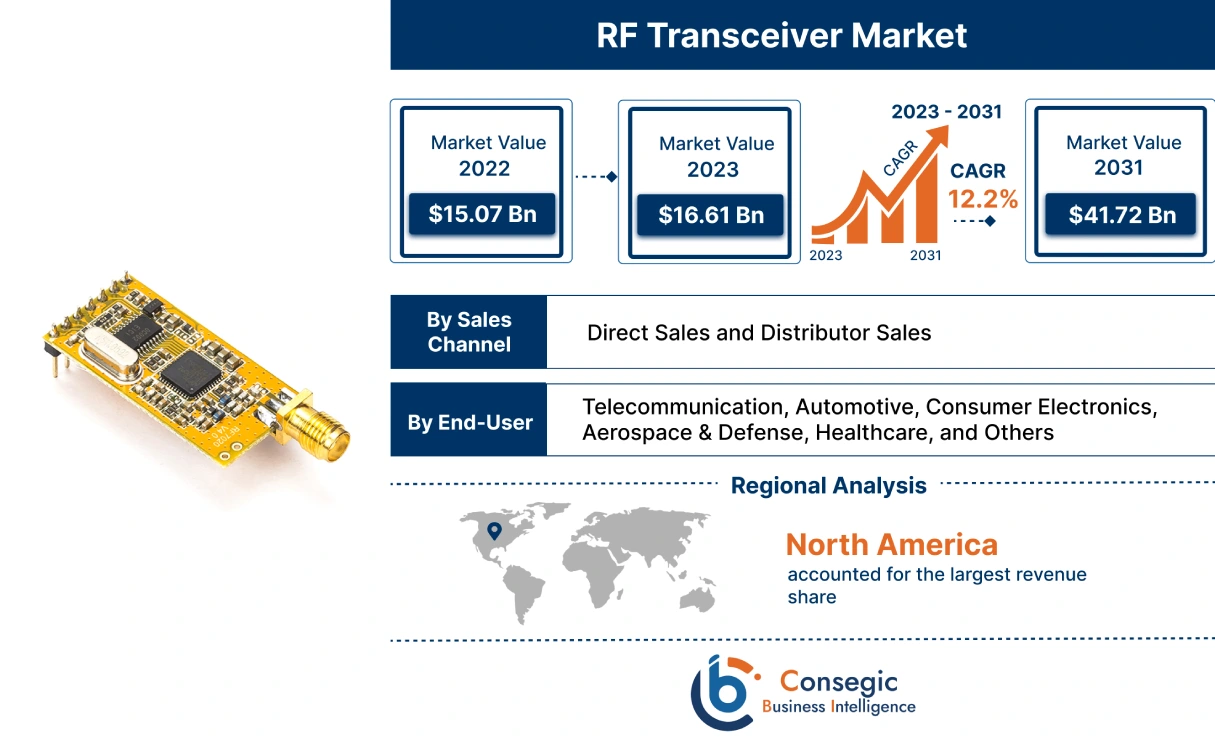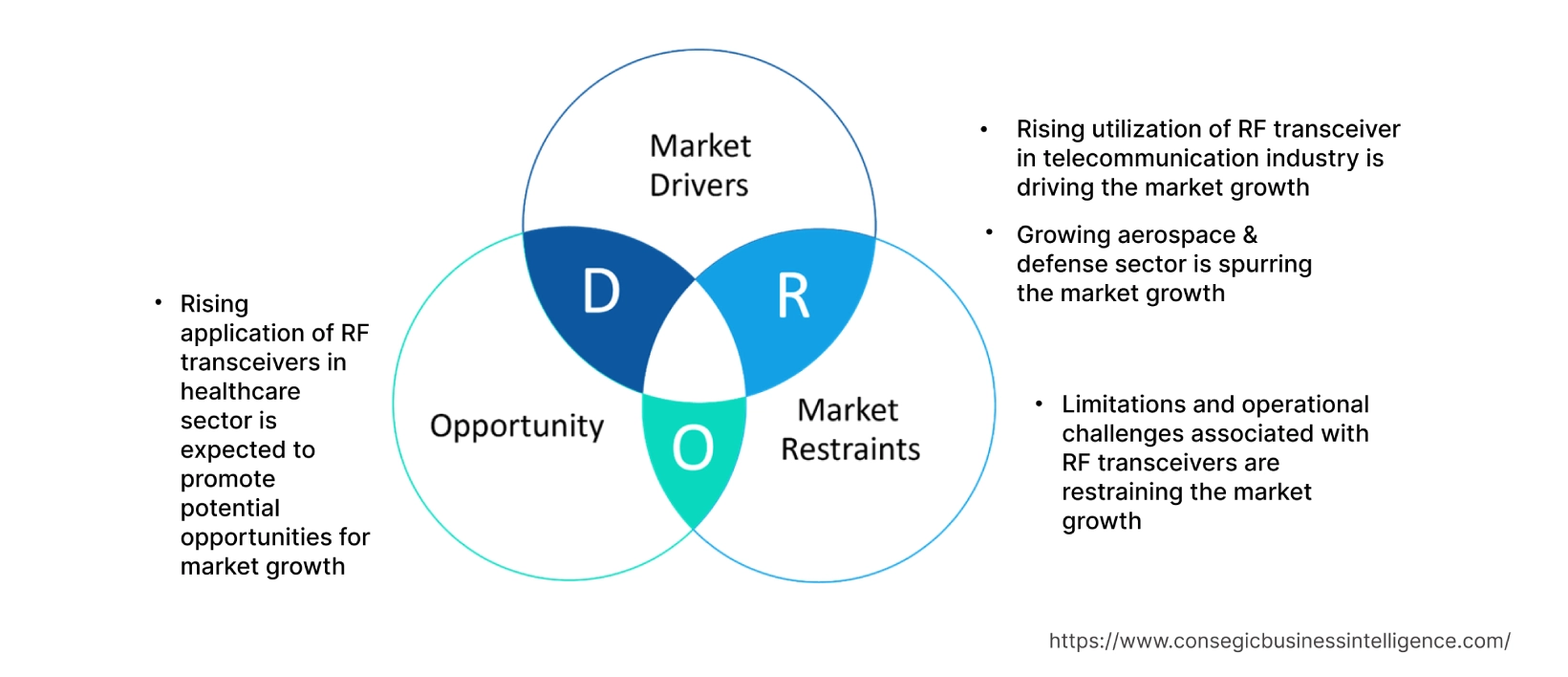- Summary
- Table Of Content
- Methodology
RF Transceiver Market Size :
Global RF Transceiver Market Size is estimated to reach over USD 41.72 Billion by 2031 from a value of USD 15.07 Billion in 2022 and is projected to grow by USD 16.61 Billion in 2023, growing at a CAGR of 12.2% from 2023 to 2031.
RF Transceiver Market Scope & Overview :
RF transceivers refer to electronic devices that are capable of receiving and demodulating radio frequency (RF) signals for further modulation and transmission of new signals. Moreover, they are capable of supporting both transmit and receive functionalities in a single module, in turn saving space and cost. They also support multiple frequency bands and avoid interference with other signals and systems. Additionally, they can be easily integrated into various types of wireless devices and systems. Their aforementioned features of are key determinants for increasing its utilization in telecommunication, automotive, consumer electronics, aerospace & defense, healthcare, and other industries.
RF Transceiver Market Insights :
Key Drivers :
Rising utilization of in telecommunication
RF transceivers are primarily used in the telecommunication sector, particularly for communication and transmission of data over the wireless medium as electromagnetic waves. Their ability of to support various frequency bands including 4G, 5G, and others make it ideal for deployment in communication base stations and network stations.
Assessment of market trends suggest that factors including the growing deployments of 5G infrastructure, rising adoption of smartphones and advanced communication devices, and increasing demand for wireless communication are major prospects driving the expansion of the telecommunication sector.
For instance, according to the Ookla 5G Map, the total deployment of 5G network reached 112 countries in November 2021, representing an incline of 13% as compared to 99 countries in November 2020. Further, according to Ookla, the overall number of 5G deployments increased considerably and reached 85,602 deployments in 2021 in contrast to 17,428 deployments in 2020.
Thus, the growth of telecommunication industry is fostering their utilization for application in telecom base stations and network stations for communication and transmission of data over the wireless medium, in turn and leads in increase of RF transceiver market demand.
Growing aerospace & defense sector
RF transceivers are used in the aerospace & defense sector for applications involving commercial aircraft, defense aircraft, military vehicles, and radar among others. Moreover, they are used in aerospace & defense systems for application in real time air-to-ground, air-to-air, and sea-to-air point to point communications. They also play a crucial role in military radar system for receiving and decoding the reflected signals in order to acquire velocity and position information about a certain target.
Analysis of RF transceivers market trends showcases that the factors including increasing aircraft production, rising commercial flight activities, and growing investments in defense vehicles are fostering the proliferation of the aerospace & defense sector.
For instance, Boeing, a North American airline company, delivered approximately 99 commercial jets during the fourth quarter of 2021, depicting a substantial incline of 68% in contrast to 59 deliveries in the fourth quarter of 2020.
Additionally, in December 2022, Dassault Aviation, a France-based manufacturer of military aircraft and business jets, launched its new Rafale fighter aircraft for deployment in the Directorate General of Armaments, a French military procurement agency. Therefore, the rising production from aerospace & defense sector is increasing their utilization for application in point-to-point communication and military radar systems, in turn is proliferating the RF transceiver market demand.
Key Restraints :
Limitations and operational challenges
The utilization of RF transceivers is usually associated with few limitations and operational challenges, which is a key factor limiting the market growth.
For instance, they mostly require medium to high power, which makes it inappropriate for battery powered applications or devices. Moreover, they are often associated with high design complexities, particularly for deployment in small devices.
Additionally, they require mandatory compliance with regulatory standards including Federal Communications Commission (FFC) regulations, Radio and Telecommunications Terminal Equipment Directive (R&TTE), Australian/New Zealand Standard (AS/NZS 4268:2003), and others. Therefore, the aforementioned limitations and operational challenges associated with them are constraining the expansion of the market.
Future Opportunities :
Rising application of in healthcare sector
The rising application of these transceivers in healthcare sector is expected to present potential opportunities for the RF transceiver market growth. They are often used in healthcare sector, particularly in healthcare monitoring systems and implantable medical devices. Moreover, their features including ultra-low power operation, compact form factor, higher accuracy, enhanced efficiency, and others are primary determinants for increasing its utilization in healthcare monitoring systems and implantable medical devices.
Analysis of RF transceivers market trends concludes that the factors including the increase in healthcare expenditure, rising incidence of chronic diseases, and growing investments in efficient medical imaging solutions for early detection of diseases are primary aspects driving the expansion of the healthcare sector.
According to American Medical Association, the total healthcare spending in the United States reached up to USD 4.3 trillion in 2021, depicting an incline of 2.7% as compared to 2020. Moreover, healthcare expenditure in the U.S. accounted for of 18.3% share of the total GDP in 2021. Additionally, the European Commission invested approximately USD 6 billion budget during the 2021-27 period for facilitating the healthcare sector in Europe.
Assessment of market trends suggest that the rising investments in healthcare industry are projected to increase their integration for application in healthcare monitoring systems and implantable medical devices, which in is emerging as one of many RF transceiver market opportunities during the forecast period.
Global RF Transceiver Market Report Insights :
| Report Attributes | Report Details |
| Study Timeline | 2017-2031 |
| Market Size in 2031 | USD 41.72 Billion |
| CAGR (2023-2031) | 12.2% |
| Based on the Sales Channel | Direct Sales and Distributor Sales |
| Based on the End-User | Telecommunication, Automotive, Consumer Electronics, Aerospace & Defense, Healthcare, and Others |
| Based on the Region | North America, Europe, Asia-Pacific, Latin America, and Middle East & Africa |
| Key Players | Analog Devices Inc., Texas Instruments Incorporated, NXP Semiconductors, Renesas Electronics Corporation, Semiconductor Components Industries LLC, Qualcomm Technologies Inc., Skyworks Solutions Inc., Toshiba Electronic Devices & Storage Corporation, Infineon Technologies AG, STMicroelectronics |
| Geographies Covered | |
| North America | U.S. Canada Mexico |
| Europe | U.K. Germany France Spain Italy Russia Benelux Rest of Europe |
| APAC | China South Korea Japan India Australia ASEAN Rest of Asia-Pacific |
| Middle East and Africa | GCC Turkey South Africa Rest of MEA |
| LATAM | Brazil Argentina Chile Rest of LATAM |
| Report Coverage | Revenue Forecast, Competitive Landscape, Growth Factors, Restraint or Challenges, Opportunities, Environment & Regulatory Landscape, PESTLE Analysis, PORTER Analysis, Key Technology Landscape, Value Chain Analysis, Cost Analysis, and Regional Trends & Forecast |
RF Transceiver Market Segmental Analysis :
By Channel :
Based on the sales channel, the market is bifurcated into direct sales and distributor sales. The largest RF transceiver market share was accounted to the distributor sales segment in the year 2022. The distributor sales channel of transceivers comprises of both offline and online modes. In the online mode, the they can be bought from e-commerce websites such as eBay, Amazon, Alibaba, and others. The offline mode allows their distribution through retail stores, specialist stores, and others. In addition, buying from a distributor also benefits the consumer to select the best product available in the market.
For instance, Analog Devices Inc. and NXP Semiconductors are among few of the transceiver manufacturers that offer a range of products through several regional distributors including Mouser Electronics Inc. Arrow Electronics Inc., and others. Therefore, their increasing availability in distributor sales channel is a prime factor proliferating the development of the segment.
The direct sales channel segment is anticipated to register the fastest CAGR growth during the forecast period. In direct sales channel, products are sold directly to customers by the means of various physical outlets such as company outlets, and others. Moreover, the direct sales channel also comprises of online mode, in which the manufacturers sell the products through its own company websites. RF transceiver market analysis suggested that purchasing transceiver from direct sales channel offers various benefits such as faster response time, higher product quality, competitive pricing, competitive pricing, and higher return on investments, which are primary factors increasing their purchase from direct sales channel.
For instance, Texas Instruments Incorporated is among few of the manufacturers that offer a broad range of products for direct purchase through company website. Thus, their availability in direct sales channels, attributing to its above benefits, is a key factor projected to drive the expansion of the segment during the forecast period.
By End-User :
Based on the end-user, the market is segregated into telecommunication, automotive, consumer electronics, aerospace & defense, healthcare, and others. The largest RF transceiver market share for end-user segment is accounted to telecommunication segment at a percentage of 31.6% in the year 2022. Analysis of market trends suggest that factors including the growing deployments of 5G infrastructure, rising adoption of smartphones and advanced communication devices, and increasing demand for wireless communication are major prospects driving the proliferation of the telecommunication segment.
According to Viavi Solutions Inc., the overall number of cities globally with 5G deployments reached 1,947 as of January 2022, along with the addition of 635 new 5G cities in 2021. Therefore, the expansion of telecommunication sector is driving their adoption for utilization in base stations and network stations for communication and transmission of data over the wireless medium, in turn proliferating the development of the market.
Assessment of market trends suggest that aerospace & defense segment is expected to witness fastest CAGR growth during the forecast period. RF transceiver market analysis suggested that the proliferation of aerospace & defense segment is driven by multiple factors including rising investments in military & defense vehicles along with increasing production of air and maritime defense systems as per military demands among others.
For instance, in April 2022, Huntington Ingalls Industries introduced its new Block IV Virginia-class attack submarine that is primarily developed for the U.S. navy. The submarine is designed for performing several coastal and open-water missions. Hence, the rising development of defense systems is increasing their adoption for application in point-to-point communication and military radar systems, in turn proliferating the market expansion during the forecast period.
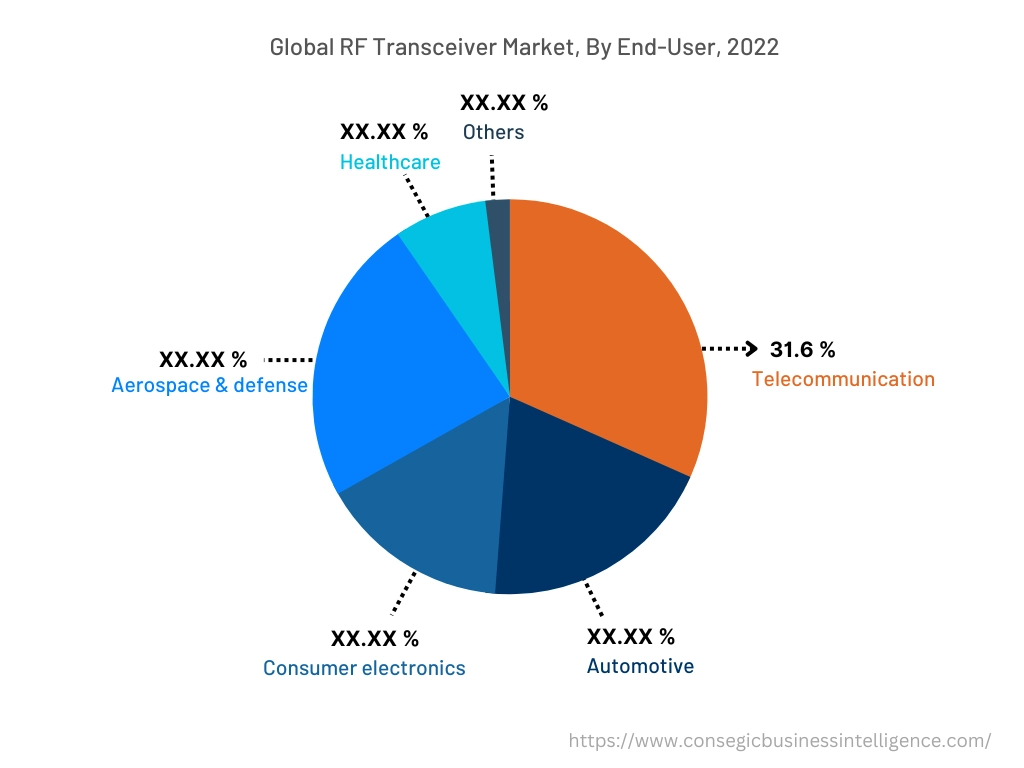
By Region :
The regional segment includes North America, Europe, Asia Pacific, Middle East and Africa, and Latin America.
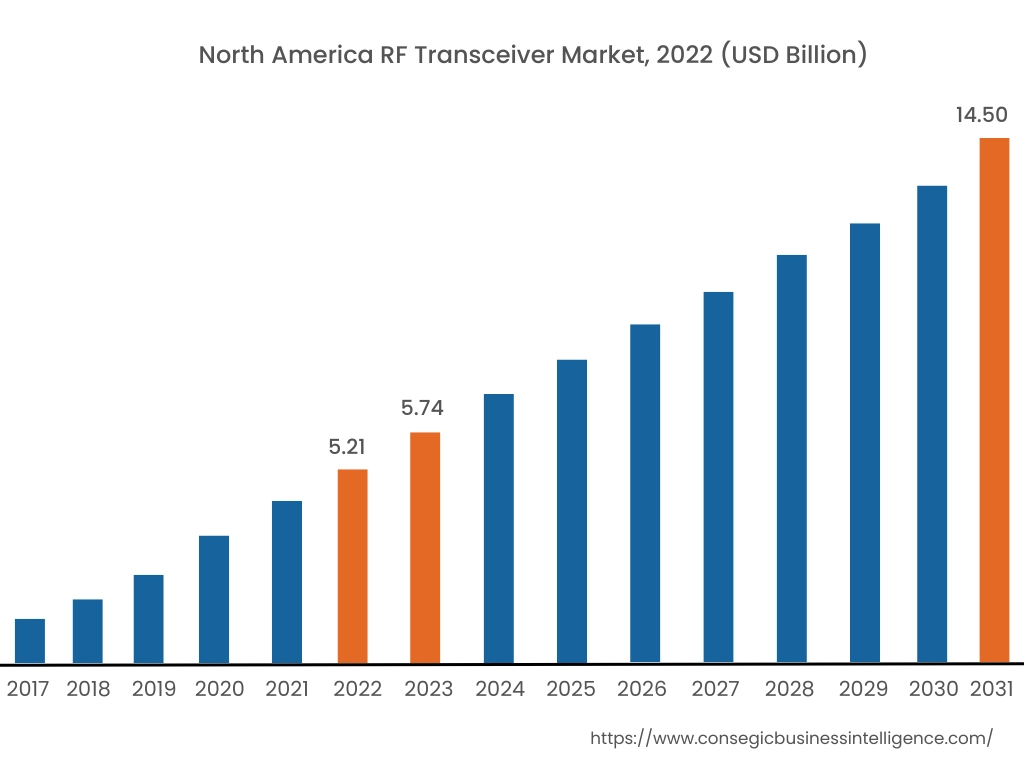
North America accounted for the largest revenue share of USD 5.21 Billion in 2022 and is expected to reach USD 14.50 Billion by 2031, registering a CAGR of 12.3% during the forecast period. Also, the market is projected to garner revenue of USD 5.74 Billion in the year 2023. In addition, in the region, the U.S. accounted for the maximum revenue share of 75.4% in the same year. Analysis of RF transceiver market trends showcases that their adoption in the North American region is primarily driven by its usage in aerospace & defense, telecommunication, automotive, healthcare, and other industries. Additionally, their rising utilization in telecommunication infrastructure including base stations and network stations for communication and transmission of data over the wireless medium as electromagnetic waves are among the significant factors driving the market expansion in the region.
For instance, according to the GSM Association, the total 5G connection deployments across North America reached nearly 140 Billion as of 2022. Thus, the growing telecommunication sector is fostering their deployment in base stations and network stations, attributing to its ability to support various frequency bands including 4G, 5G, and others, in turn driving market proliferation in the North American region. Analysis of RF transceiver market trends showcases that the factors including the increasing investment in aviation & defense and healthcare sectors are anticipated to foster opportunities for market expansion in North America during the forecast period.
Asia-Pacific is expected to register the fastest CAGR growth of 12.5% during the forecast period. The growing pace of industrialization and development is creating lucrative proliferation prospects for the market in the region. Additionally, factors including the expansion of multiple industries such as consumer electronics, telecommunication, aerospace & defense, and others are driving their market growth in the Asia-Pacific region.
For instance, according to Invest India, the Government of India allocated USD 70.6 billion to the Ministry of Defense as the part of its Union Budget 2022-23. The primary focus of the budget allocation to the Indian Ministry of Defense is to help in the development of new unmanned aerial vehicles and systems, military ground vehicles, and other related systems. Hence, rising investment in aerospace & defense sector is anticipated to drive their utilization for application in point-to-point communication system and military radar system, thereby, driving market growth in the Asia-Pacific region during the forecast period.
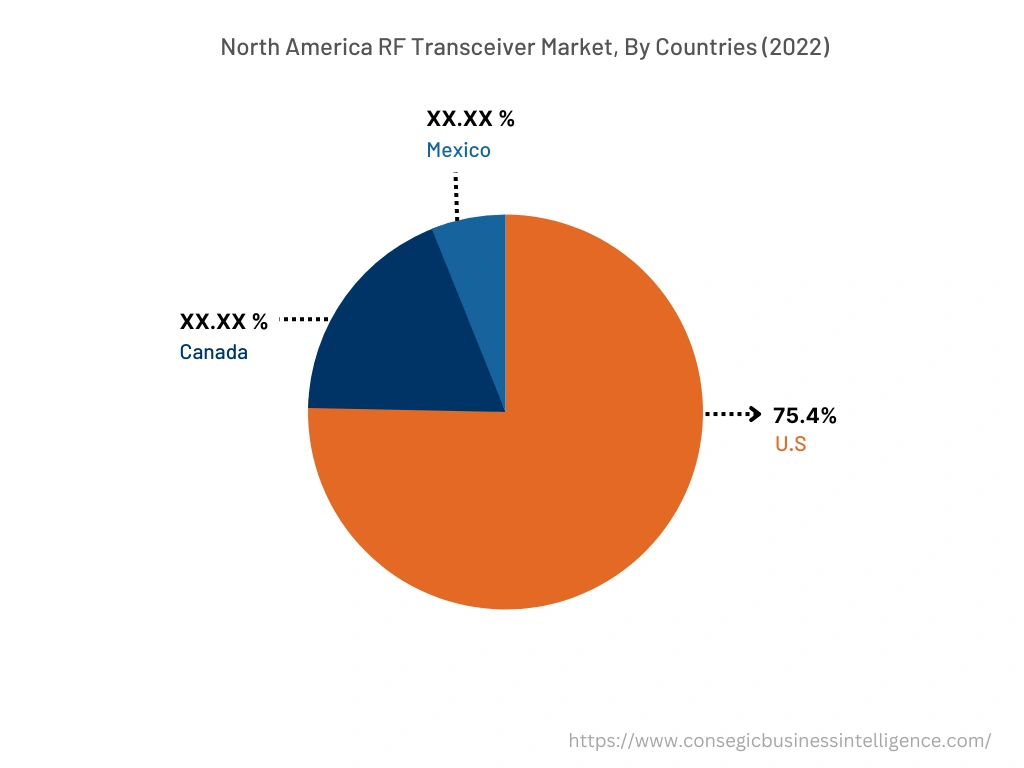
Top Key Players & Market Share Insights :
The global RF transceiver market is highly competitive with major players providing products to the national and international markets. companies operating in RF transceiver industry are adopting several strategies in research and development (R&D), product innovation, and end-user launches to hold a strong position in market. Key players in the RF transceiver market include-
- Analog Devices Inc.
- Texas Instruments Incorporated
- Toshiba Electronic Devices & Storage Corporation
- Infineon Technologies AG
- STMicroelectronics
- NXP Semiconductors
- Renesas Electronics Corporation
- Semiconductor Components Industries LLC
- Qualcomm Technologies Inc.
- Skyworks Solutions Inc.
Recent Industry Developments :
- In February 2022, Renesas Electronics Corporation developed two RF transceiver technologies that is capable of supporting the Bluetooth and near-field communication standard. The new products offer a smaller mounting area along with improved power efficiency.
Key Questions Answered in the Report
What is RF transceiver? +
RF transceivers refer to electronic devices that are capable of receiving and demodulating radio frequency (RF) signals for further modulation and transmission of new signals.
What specific segmentation details are covered in the RF transceiver report, and how is the dominating segment impacting the market growth? +
For instance, by sales channel segment has witnessed distributor sales as the dominating segment in the year 2022, owing to its range of benefits including higher accessibility to a variety of products, ease of use, and high flexibility.
What specific segmentation details are covered in the RF transceiver market report, and how is the fastest segment anticipated to impact the market growth? +
For instance, by end-user segment has witnessed aerospace & defence as the fastest-growing segment during the forecast period due to rising adoption of RF transceiver in aviation & defence applications including point-to-point communication and radar systems.
Which region/country is anticipated to witness the highest CAGR during the forecast period, 2023-2031? +
Asia-Pacific is anticipated to register fastest CAGR growth during the forecast period due to rapid pace of industrialization and growth of multiple industries such as consumer electronics, telecommunication, aerospace & defence, and others.
